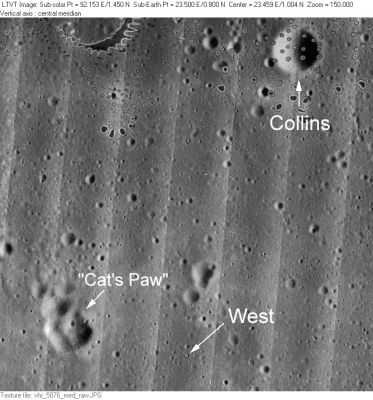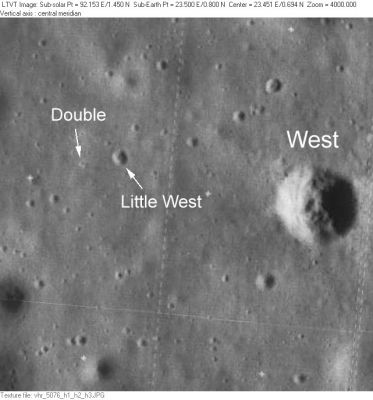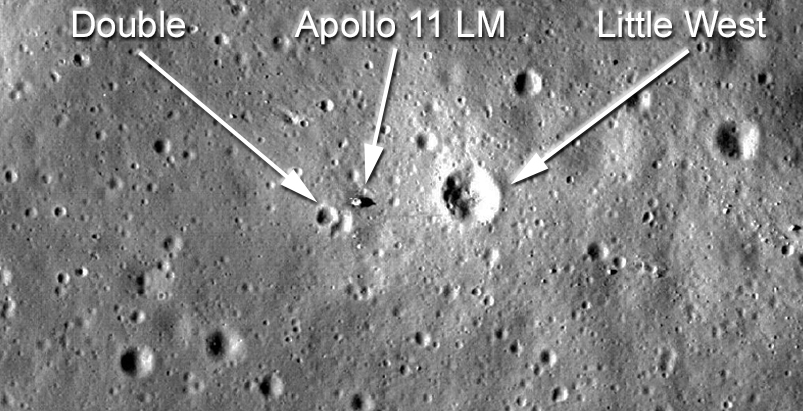West
Contents
West (Apollo 11 site craterlet name)
|
Lat: 0.8°N, Long: 23.5°E, Diam: 0.18 km, Depth: 0.03 km, [/R%C3%BCkl%2035 Rükl: 35] |
Table of Contents
[#West (Apollo 11 site craterlet name) West (Apollo 11 site craterlet name)]
[#West (Apollo 11 site craterlet name)-Images Images]
[#West (Apollo 11 site craterlet name)-Maps Maps]
[#West (Apollo 11 site craterlet name)-Description Description]
[#West (Apollo 11 site craterlet name)-Description: Wikipedia Description: Wikipedia]
[#West (Apollo 11 site craterlet name)-Additional Information Additional Information]
[#West (Apollo 11 site craterlet name)-Nomenclature Nomenclature]
[#West (Apollo 11 site craterlet name)-APOD Articles APOD Articles]
[#West (Apollo 11 site craterlet name)-Bibliography Bibliography]


Left: LO-V-076M; Right: LO-V-076H
The view on the left, taken by the medium resolution camera onboard [/Lunar%20Orbiter Lunar Orbiter] V, shows the location of the IAU-named crater West in relation to [/Collins Collins] and the informally named "Cat's Paw", both of which can, when conditions are just right, be seen though amateur telescopes from Earth. The pair of roughly 1-km diameter craters to the east of the "Cat's Paw" can also be barely seen on the best amateur photos.
The view on the right, taken at the same instant with Lunar Orbiter V's high resolution camera, shows West in more detail. The crater names "Double" and "Little West" are informal names that appear on the Site Traverses Map of the Apollo 11 Landing Site. In its final approach (coming in from the right), the lunar module flew just north of West, passing directly over "Little West" (called "East" on some NASA maps), and finally touching down just short of "Double" crater. Some parts of the rims of the "Cat's Paw" craters can reportedly be seen from this location.
Images
LPOD Photo Gallery Lunar Orbiter Images Apollo Images
Is craterlet West' visible on Apollo 11's LEVA photographs made by Neil Armstrong? (photographs made while Edwin Aldrin descended LM Eagles ladder) (something of a shadowed eastern inner slope of a crater is visible in the distance, looking eastward under the LM's Descent Stage, sans the disturbing glare of the morning sun's light). - DannyCaes DannyCaes Oct 18, 2015

- JohnMoore2 JohnMoore2
Maps
([/LAC%20zone LAC zone] 60C4) LAC map Geologic map LM map AIC map Site Traverses Map
Description
Description: Wikipedia
Additional Information
- West is about 185 m in diameter and, according to the primary shadow in LO-V-076H, is about 30 m deep. The central peak, casting a tiny secondary shadow, is about 7 m tall. The official IAU diameter is "O km", a common notation for a [/Landing%20Site%20Name Landing Site Name].
- In the coordinate system used to calibrate these [/LTVT LTVT] versions of the Lunar Orbiter images, the Apollo 11 Lunar Ranging Retroreflector (LRRR), placed just outside the SE rim of the "Double" crater, is at 0.697°N, 23.444°E. The [/ULCN#Fundamental_points true coordinates] of the LRRR in the Mean Earth/Polar coordinates system are 0.67337°N, 23.47293°E. Hence the positions given at the top of the LTVT images need to be shifted by about 0.03 degrees (or about 1 km on the lunar surface). Locating points on the Moon to this precision is surprisingly difficult because of the lack of well-determined reference points. In fact, during its brief stay on the Moon, the Apollo 11 mission controllers were unable to give Command Module pilot Michael Collins sufficiently accurate coordinates for him to find the landing craft visually by reference to previously-established features. The idea that this particular LTVT calibration needs to be corrected by about 0.03 degrees is quite consistent with the offset observed at the independently-determined Apollo Landmark Tracking point near [/Collins Collins]. - JimMosher JimMosher
- It had been suggested that West crater might have been named for Mareta N. West, a geologist who worked on NASA's Geology Experiment Team during the Apollo 11 mission. It was discovered that West may have been the first to suggest that West crater was the crater that Armstrong had dodged during landing and possibly even on landing day based on the crews description of the approach and of the landing site. Further investigation, however, stongly suggested that the crater had in fact been named prior to the mission for its location in the western part of the Apollo 11 landing ellipse and any connection with Mareta West was a coincidence. This investigation was initiated by Apollo Lunar Surface Journal editor Eric Jones and included a discussion and some research by Ewen Whitaker of the Lunar and Planetary Laboratory after discussions with the current contributor. - jscotti jscotti
Nomenclature
- Little West was officially approved by the IAU on the 26 July 2017 - JohnMoore2 JohnMoore2
- IAU Official pages (Little West and Double) - JohnMoore2 JohnMoore2
- Astronaut-named feature, [/Apollo%2011%20site Apollo 11 site]. This crater served as a landmark near the west end of the planned landing ellipse.
APOD Articles
- APOLLO 11 panorama made at Little West crater (aka East crater), east of LM Eagle
- APOLLO 11 panorama made from CDR Neil Armstrong's LM window (shows the Double crater)
Bibliography
This page has been edited 1 times. The last modification was made by - tychocrater tychocrater on Jun 13, 2009 3:24 pm - afx4